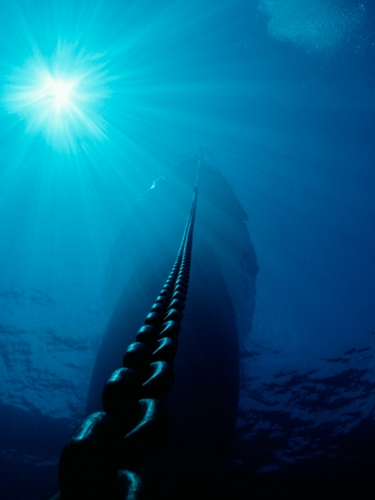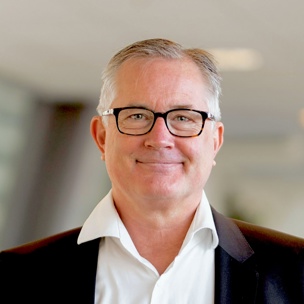Cable breaks in the Baltic Sea part of a bigger challenge
Recent incidents involving severed internet cables under the Baltic Sea have highlighted the vulnerability of today's digital infrastructure. However, protecting internet cables is just one piece of the much larger challenge of building more resilient solutions for the entire digital infrastructure that our society depends on. Achieving a comprehensive solution requires many efforts and solutions, according to cybersecurity expert Johan Malmliden and IVA Fellow Daniel Akenine, both involved in IVA's Resilient Digital Infrastructure project.

In recent months, several internet cables on the Baltic Sea floor have been severed. Additionally, many of these disruptions are suspected to be deliberate sabotage carried out on behalf of foreign powers. The cables are vital highways for internet traffic between Sweden and other countries, but they are only part of the digital infrastructure that every modern society depends on to function. This includes both physical infrastructure and virtual systems and technologies.
"The digital infrastructure consists of many different components across multiple layers. Everything from telecommunications technology, internet cables, power systems, and data centres, to all the applications connected to the physical infrastructure. It also includes all the data we handle and store within it, and the human expertise required to make everything work", says Daniel Akenine, who has been the national technology officer at Microsoft Sweden for the past fifteen years.
Digital resilience is not a new issue
The need to build resilience into digital infrastructure is not a new issue. Many companies and authorities have been working on it for several decades. As a result, a certain level of robustness and resilience is already built into many critical systems. One example is the physical part of the internet, which includes the damaged cables under the Baltic Sea. Although the type of cable breakage that has occurred now causes serious disruptions in the system, it does not stop the traffic, says Daniel Akenine.
"The internet is designed to be resilient to cable breaks, but there are, of course, limits. If an internet cable is cut today, the traffic will be rerouted via alternative paths, but this can lead to local outages, increased load, or delays."
Even though these submarine cables must be managed properly to ensure there are always alternative routes, there are also measures that need to be taken in other systems. In recent years, several reports and investigations have highlighted the need for significant investments to strengthen the digital infrastructure in Sweden and Europe. This is not only because it is essential to withstand future civilian and military threats, but also because stable digital systems are crucial for Sweden's and Europe's competitiveness and ability to ensure economic security. A resilient digital infrastructure is also a prerequisite for benefiting from innovation and the rapid digital transformation, such as what we have recently seen in the field of artificial intelligence.
Must be seen as an ecosystem
Even though many efforts are being made to strengthen digital infrastructure, they are all too often done in silos. Generally, in Sweden, we are a country that likes to discuss and collaborate before taking action, which delays measures and, consequently, the desired effect. At the same time, when individual actors take measures, it is often done without fully realizing that they are part of an interconnected ecosystem, where their own resilience affects and is affected by the resilience of other parts of the system. We must be able to act quickly while ensuring that each measure can have maximum impact.
In many countries, there have been calls for greater investments and action plans to coordinate the efforts of various actors. The action plans we have in Sweden do not account for robustness.
"We need to think this through and ensure that we build robustness into our operations. We must understand how they are interconnected and dependant on each other," says Johan Malmliden , CEO of the cybersecurity group OmegaPoint.
A current example is the fires that raged in Los Angeles, costing American society lives and thousands of billions of SEK.
"Here, the capacity to limit the spread of the fires has decreased because they have suffered blackouts when the power system was not resilient enough to withstand the fires. This has resulted in the loss of the ability to operate the pumps that supply the fire brigade with water," says Johan Malmliden.
Investments require incentives
In Sweden, there needs to be clearer responsibility regarding the resilience of digital infrastructure. The responsibility to build systems that are interconnected and capable of meeting future demands and challenges is spread across many individual actors, both in the public sector and in business. To build a functioning ecosystem at all levels, clear incentives are needed for individual actors to invest in their part of the development. However, it also requires a culture where there are mutual demands to do so, says Daniel Akenine.
"Today, for example, you have many buyers of digital services who do not require that the providers of these services have built resilience into their systems. They are not used to doing so and do not see the need for it. I believe we need to create incentives that drive this development in the right direction. If you understand the ecosystem well, you can stimulate it so that it forces itself to become more resilient without increasing bureaucracy in the form of coordination and collaboration, and thus delays.
Facts
NATO Protection of Critical Infrastructure in the Baltic Sea
On January 9th, the government decided that the Swedish Armed Forces will participate in a NATO mission to deter sabotage against critical underwater infrastructure in the Baltic Sea. Several ships and a surveillance aircraft will be part of the force.
This is the first time Sweden, as an ally, contributes an armed force to NATO's deterrence and defence. (source: regeringen.se)
IVAs Project Resilient Digital Infrastructure
The overarching goal of the project is to ensure that Sweden’s digital infrastructure, in terms of capacity, quality, and security, can compete with the most advanced countries in the world. The project brings together various perspectives to propose concrete and actionable measures that enhance the resilience of the digital infrastructure.
Learn moreAbout Daniel Akenine
Daniel Akenine is the National Technology Officer at Microsoft Sweden, one of the country's largest providers of IT and digital services. Daniel Akenine holds a Master of Science in Engineering Physics and has previously conducted many years of research on how the brain and its magnetic fields function, which is relevant to the construction of today's AI systems.
Daniel Akenine has been a Fellow of IVA since 2023 and is a member of the steering committee for IVA's Resilient Digital Infrastructure project.

About Johan Malmliden
Johan Malmliden is the CEO and Group Chief Executive of Omegapoint, Nordic experts in cyber-secure digitalisation. He holds a Master of Science in Applied Mechanics and a PhD in Applied Mathematics. Johan Malmliden has previously run companies focused on control systems and process safety in the industrial and power sectors, and is now a member of the steering committee for IVA's Resilient Digital Infrastructure project.



